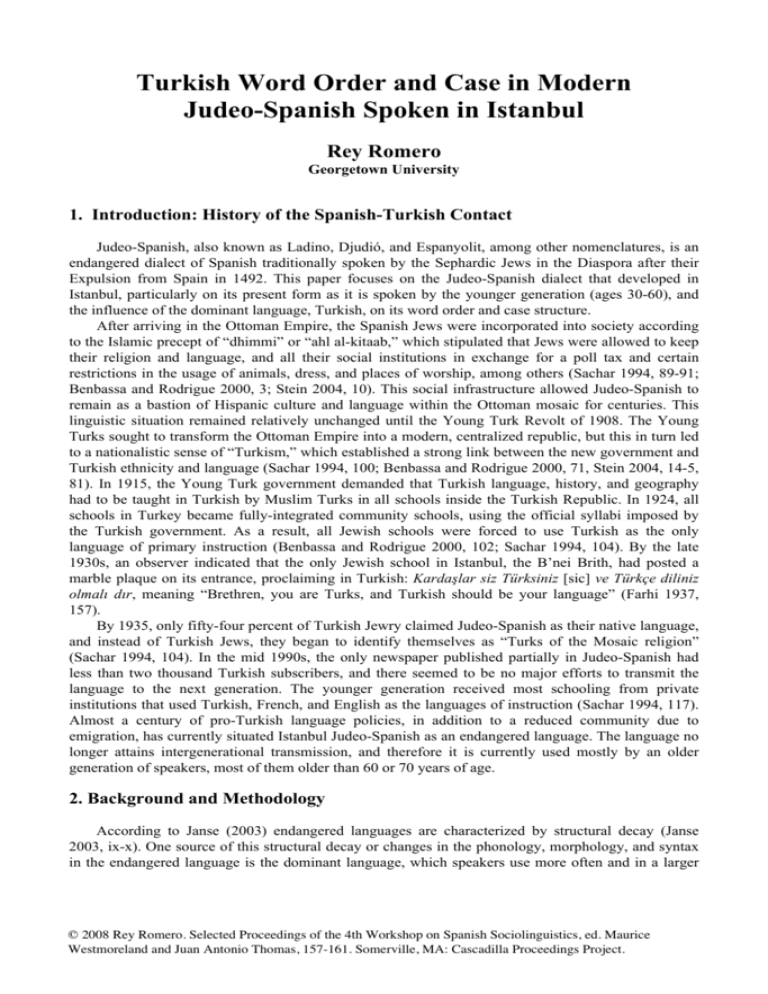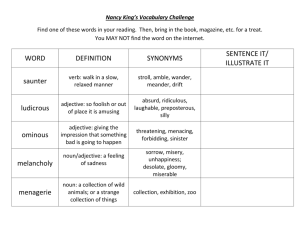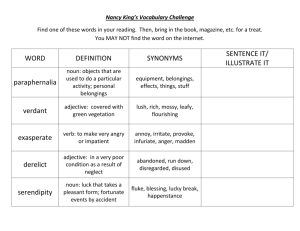
Turkish Word Order and Case in Modern
Judeo-Spanish Spoken in Istanbul
Rey Romero
Georgetown University
1. Introduction: History of the Spanish-Turkish Contact
Judeo-Spanish, also known as Ladino, Djudió, and Espanyolit, among other nomenclatures, is an
endangered dialect of Spanish traditionally spoken by the Sephardic Jews in the Diaspora after their
Expulsion from Spain in 1492. This paper focuses on the Judeo-Spanish dialect that developed in
Istanbul, particularly on its present form as it is spoken by the younger generation (ages 30-60), and
the influence of the dominant language, Turkish, on its word order and case structure.
After arriving in the Ottoman Empire, the Spanish Jews were incorporated into society according
to the Islamic precept of “dhimmi” or “ahl al-kitaab,” which stipulated that Jews were allowed to keep
their religion and language, and all their social institutions in exchange for a poll tax and certain
restrictions in the usage of animals, dress, and places of worship, among others (Sachar 1994, 89-91;
Benbassa and Rodrigue 2000, 3; Stein 2004, 10). This social infrastructure allowed Judeo-Spanish to
remain as a bastion of Hispanic culture and language within the Ottoman mosaic for centuries. This
linguistic situation remained relatively unchanged until the Young Turk Revolt of 1908. The Young
Turks sought to transform the Ottoman Empire into a modern, centralized republic, but this in turn led
to a nationalistic sense of “Turkism,” which established a strong link between the new government and
Turkish ethnicity and language (Sachar 1994, 100; Benbassa and Rodrigue 2000, 71, Stein 2004, 14-5,
81). In 1915, the Young Turk government demanded that Turkish language, history, and geography
had to be taught in Turkish by Muslim Turks in all schools inside the Turkish Republic. In 1924, all
schools in Turkey became fully-integrated community schools, using the official syllabi imposed by
the Turkish government. As a result, all Jewish schools were forced to use Turkish as the only
language of primary instruction (Benbassa and Rodrigue 2000, 102; Sachar 1994, 104). By the late
1930s, an observer indicated that the only Jewish school in Istanbul, the B’nei Brith, had posted a
marble plaque on its entrance, proclaiming in Turkish: Kardaşlar siz Türksiniz [sic] ve Türkçe diliniz
olmalı dır, meaning “Brethren, you are Turks, and Turkish should be your language” (Farhi 1937,
157).
By 1935, only fifty-four percent of Turkish Jewry claimed Judeo-Spanish as their native language,
and instead of Turkish Jews, they began to identify themselves as “Turks of the Mosaic religion”
(Sachar 1994, 104). In the mid 1990s, the only newspaper published partially in Judeo-Spanish had
less than two thousand Turkish subscribers, and there seemed to be no major efforts to transmit the
language to the next generation. The younger generation received most schooling from private
institutions that used Turkish, French, and English as the languages of instruction (Sachar 1994, 117).
Almost a century of pro-Turkish language policies, in addition to a reduced community due to
emigration, has currently situated Istanbul Judeo-Spanish as an endangered language. The language no
longer attains intergenerational transmission, and therefore it is currently used mostly by an older
generation of speakers, most of them older than 60 or 70 years of age.
2. Background and Methodology
According to Janse (2003) endangered languages are characterized by structural decay (Janse
2003, ix-x). One source of this structural decay or changes in the phonology, morphology, and syntax
in the endangered language is the dominant language, which speakers use more often and in a larger
© 2008 Rey Romero. Selected Proceedings of the 4th Workshop on Spanish Sociolinguistics, ed. Maurice
Westmoreland and Juan Antonio Thomas, 157-161. Somerville, MA: Cascadilla Proceedings Project.
158
number of contexts. These changes or structural consequences are the result of the endangered
language assimilating to the structures present in the dominant language, whether by preserving
structures that are found in the dominant language (preservation) and deleting structures that are not
(subtractive assimilation), or by creating innovative structures that mimic those present in the
dominant language (additive assimilation) (Campbell and Muntzel 1989, 186; Sankoff 2004, 643, 647,
650-2, 658; Andersen 1982, 94-95).
This study is part of a broader research that attempts to map structural consequences in JudeoSpanish across several generations of Sephardic Jews living in Istanbul. For this purpose, a
questionnaire was administered to twenty-five speakers of Judeo-Spanish in Istanbul, ages 19 to 95,
during March and April of 2007. This questionnaire consisted of the oral translation of 61 sentences
from Turkish to Judeo-Spanish. A sample exercise of the translation task is the Turkish sentence in (1)
below:
(1) Yeni gelin-ler mutlu
new bride-pl happy
‘The new brides are happy.’
This sentence was translated into Judeo-Spanish by the following speakers (identified by gender and
age) as:
(2) las novias muevas están muy orozas (by F60)
(3) las novias muevas están orozas (by F58B)
(4) las espozas muevas están orozas (by F54)
(5) las muevas novias está buenas (by F43)
(6) muevo novias están kontente (by M30)
These sentences were designed in such a way that the Spanish translation contained morphological and
syntactic features, namely gender and number agreement in articles, nouns, and adjectives, subject and
verb agreement, ser vs. estar usage, the position of the adjective within the noun phrase, and the
presence of the indicative or subjunctive in subordinate clauses. Thus, the sentences in (2) to (6) allow
us to observe morphological features such as gender and number (novias ‘brides’ is a feminine plural
noun), as well as syntactic features such as the position of the adjective inside the noun phrase. For this
particular study, I have analyzed the results of the youngest generation of speakers, ages 30-60,
because these informants experienced the greatest linguistic impact from the pro-Turkish campaigns
and mass emigrations that occurred in the community during the 1940s and 1950s. Therefore, these
informants grew up speaking Turkish as their main language, and using Judeo-Spanish minimally, if at
all, inside the home. The 19-25 year old speakers were not included in this study because they were not
able to produce any sentences, and their responses were limited to recognizing Spanish words or
rephrasing Spanish sentences in Turkish. Several previous studies, such as Dorian 1981 on Scottish
Gaelic and Holloway 1997 on Brulé Spanish, have used a translation exercise as a way to maintain
some control on the number and type of features that are expected to be produced by the informant.
This, however, is by no means a test of their translation skills, but rather a way to expose them to the
same “picture” in order to elicit comparable responses. Their response, thus, is perceived as an
utterance which they consider grammatical and communicable Judeo-Spanish.
3. Results Regarding Word Order: Placement of Adjectives
In Judeo-Spanish, like in Castilian Spanish, adjectives may be placed before or after the noun
inside the noun phrase. Thus:
(7) las kazas koreladas
the houses red-plural
‘the red houses’
(8) la blanka inyeve
the white snow
‘the white snow’
159
In (7) the adjective ‘koreladas’ has been placed after the noun ‘kazas,’ and in (8) the adjective
‘blanka’ has been placed before the noun ‘inyeve.’ This alternation, however, follows a semantic
distinction. Thus, differentiating adjectives, or adjectives that single out the noun from a group, are
traditionally placed after the noun. In (7) the adjective ‘koreladas’ singles out the noun ‘kazas’ from a
group of other houses that are not red. Non-differentiating adjectives, or inherent adjectives, are
adjectives that refer to a quality inherent to the noun they describe, and they tend to be placed before
the noun. Thus, in (8), the adjective ‘blanka’ is placed before the noun ‘inyeve’ because white is an
inherent quality of snow.
However, much like English, Turkish does not have this alternation, and it does not distinguish
between differentiating and inherent adjectives. In Turkish, the only placement of adjectives inside the
noun phrase is before the noun. Thus, (7) and (8) above can be expressed in Turkish as (9) and (10):
(10) beyaz kâr
white snow
‘the white snow’
(9) kırmızı ev-ler
houses red-plural
‘the red houses’
In fact, placing an adjective after the noun would result in a complete sentence, since the copula in
Turkish is Ø (zero). Thus, if we were to change the order of the adjective and noun in the noun phrase
in (10), it would give us the complete sentence of (11):
‘The snow is white.’
(11) Kâr
Ø
beyaz.
snow copula white
Table 1 below illustrates the placement of the differentiating adjective in the Judeo-Spanish Noun
Phrase by speakers ages 30 to 60:
27
27
27
23
24
21
15
13
12
11
9
10
6
3
2
M30
F40
4
0
F43
F44
F49
Differentiating Adjective + Noun
Noun + Differentiating Adjective
2
F54
F58b
F58a
F60
160
As Table (1) above illustrates, younger speakers display a higher tendency to situate
differentiating adjectives before the noun in the noun phrase, similar to the Turkish pattern. Some of
their sample answers are (12) and (13) below:
(12) F43: los kontentes pasharós están en un aach.
‘The happy birds are [sitting] on a tree.’
(13) M30: ermozo pasharó está adientro de kaza.
‘[The] beautiful bird is inside the house.’
Conversely, the older speakers in their fifties exhibit a higher tendency to place differentiating
adjectives after the noun in the noun phrase, that is, a pattern faithful to the Judeo-Spanish system
illustrated in (14) and (15) below:
(14) F54: el pasharó ermozo está en la kaza.
‘The beautiful bird is inside the house’
(15) F60: mis tíos están meldando los livros grandes.
‘My uncles are reading the big books.’
Having these considerations in mind, we can conclude that Judeo-Spanish is losing its distinction
between differentiating and inherent adjectives among the younger generation, namely those speakers
in their thirties and forties. We can also conclude that this may be the result of Turkish influence, since
the Turkish system does not have this distinction and the only place for adjectives in the noun phrase is
before the noun. This may be an example of both preservation and subtractive assimilation, since the
Judeo-Spanish feature found in the dominant language Turkish (adjective before noun) is preserved,
whereas the feature that is not found (adjective after the noun) is lost.
4. Results Regarding Case: Particle en before objects
In addition to preservation and subtractive assimilation in the morphosyntax of young people’s
Judeo-Spanish, there may be some examples of additive assimilation in its syntax, rooted in the
Turkish case system. Turkish subjects, verbs, and objects establish their relation to one another by
pronominal suffixes on the verb and by case suffixes on the noun. Thus, the sentence in (16) shows
this relationship with the accusative case (ACC).
(16) biz ekmeğ-i
y-iyor
-uz.
we bread-ACC eat-progessive-we
‘We are eating the bread.’
Thus, in addition to a conjugation of the verb with the pronominal suffix (-uz) corresponding to the
subject (biz), the object is also marked with the accusative marker (-i) to indicate what kind of relation
is established with the verb and subject. There are about seven cases in Modern Turkish.
Taking the Turkish case system into consideration, some speakers used the preposition en before
the object of the sentence, as illustrated in (17), (18), and (19) below:
(17) F40: el novio kiere ver en el muevo novia.
‘The groom wants to see [en] the new bride’
(18) F40: mi madre kiere ir en su tante.
‘My mother wants to go to [en] her auntie’s’
(19) M30: los tantes kieres bien en las komidas kaéntes.
‘The aunties like [en] hot food(s)’
I must note that not all speakers exhibited this pattern, which was rather sporadic. In any case, it seems
that the few speakers who employ the preposition en are doing so to mark the object of the sentence, as
some sort of oblique (non-subject) noun marker. We can consider the preposition en and its oblique
value as an additive effect from the Turkish case system. However, an alternate explanation may be
found in the nature of the endangered language itself. Andersen (1982) claims that compensatory
strategies may occur in the morphology and syntax of an endangered language in order to recover
information lost as a result of structural changes (Andersen 1982, 100-5).If we observe the JudeoSpanish of the younger speakers, we note that there is very poor subject-verb agreement. For example,
in (19) above, the verbal conjugation is in the second person singular (kieres), whereas the subject is
161
third person plural (los tantes). Thus, if the relationship between the subject and the verb cannot be
easily established, a compensatory strategy may arise by which speakers identify the object of the
sentence. The preposition en may play this role in the Judeo-Spanish spoken by the youngest
generation.
5. Conclusion
In this short study, I have attempted to identify some possible structural changes in the word order
and case exhibited in young people’s Judeo-Spanish in Istanbul resulting from Turkish influence. This
particular generation suffered the most powerful effect of Turkification and nationalism; therefore their
Judeo-Spanish displays preservation, subtractive, and additive assimilation to Turkish as a result of
their higher proficiency in the dominant language. We also observe that young people still use this
language to some degree, and there are even innovative compensatory strategies used to repair its
structural decay. In the future generations, it will be interesting to observe if Judeo-Spanish disappears,
completely displaced by Turkish, or if it survives along with structural changes and adaptations as the
language of Turkish Jewry.
References
Andersen, Roger W. (1982). “Determining the linguistic attributes of language attrition” in Barbara F. Freed and
Richard Lambert (eds.). The Loss of Language Skills. Rowley: Newbury House.
Benbassa, E. and A. Rodrigue (2000). Sephardi Jewry: A History of the Judeo-Spanish Community, 14th-20th
Centuries. Los Angeles: University of California.
Campbell, Lyle and Martha C. Muntzel (1989). “The structural consequences of language death” in Nancy C.
Dorian (ed.) Investigating Obsolescence: Studies in Language Contraction and Death. Cambridge:
Cambridge University.
Dorian, Nancy C. (1981). Language Death: the life cycle of a Scottish Gaelic dialect. Philadelphia: University of
Pennsylvania.
Farhi, Gentille (1937). “La situation linguistique du Séphardite à Istanbul.” Hispanic Review 5-2, 151-8.
Holloway, Charles E. (1997). Dialect Death: The Case of Brule Spanish. John Benjamins: Amsterdam.
Janse, Mark. (2003). “Language death and language maintenance” in Janse, M. and S. Tol (eds.) Language Death
and Language Maintenance: Theoretical, practical and descriptive approaches. Amsterdam: Benjamins.
Sachar, Howard (1994). Farewell España: The World of the Sephardim Remembered. New York: Vintage.
Sankoff, Gillian (2004). “Linguistic Outcomes of Language Contact” in J.K. Chambers, Natalie Schilling-Estes,
and Peter Trudgill (eds.) The Handbook of Language Variation and Change. Oxford: Blackwell.
Séphiha, Haïm-Vidal (1997). Judeo-Spanish: A European Heritage. Brussels: Vanden Broele.
Stein, Sarah Abrevaya (2004). Making Jews Modern: The Yiddish and Ladino Press in the Russian and Ottoman
Empires. Bloomington: Indiana University Press.
Wexler, Paul (1981). Jewish Interlinguistics: Facts and Conceptual Framework. Language 57, 99-149.
Selected Proceedings of the 4th
Workshop on Spanish Sociolinguistics
edited by Maurice Westmoreland
and Juan Antonio Thomas
Cascadilla Proceedings Project
Somerville, MA
2008
Copyright information
Selected Proceedings of the 4th Workshop on Spanish Sociolinguistics
© 2008 Cascadilla Proceedings Project, Somerville, MA. All rights reserved
ISBN 978-1-57473-426-3 library binding
A copyright notice for each paper is located at the bottom of the first page of the paper.
Reprints for course packs can be authorized by Cascadilla Proceedings Project.
Ordering information
Orders for the library binding edition are handled by Cascadilla Press.
To place an order, go to www.lingref.com or contact:
Cascadilla Press, P.O. Box 440355, Somerville, MA 02144, USA
phone: 1-617-776-2370, fax: 1-617-776-2271, e-mail: sales@cascadilla.com
Web access and citation information
This entire proceedings can also be viewed on the web at www.lingref.com. Each paper has a unique document #
which can be added to citations to facilitate access. The document # should not replace the full citation.
This paper can be cited as:
Romero, Rey. 2008. Turkish Word Order and Case in Modern Judeo-Spanish Spoken in Istanbul. In Selected
Proceedings of the 4th Workshop on Spanish Sociolinguistics, ed. Maurice Westmoreland and Juan Antonio
Thomas, 157-161. Somerville, MA: Cascadilla Proceedings Project.
or:
Romero, Rey. 2008. Turkish Word Order and Case in Modern Judeo-Spanish Spoken in Istanbul. In Selected
Proceedings of the 4th Workshop on Spanish Sociolinguistics, ed. Maurice Westmoreland and Juan Antonio
Thomas, 157-161. Somerville, MA: Cascadilla Proceedings Project. www.lingref.com, document #1766.










